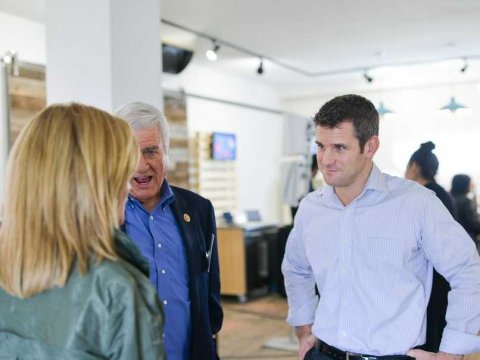#Leadership : Top CHROs Discuss Culture In A Digital World…It’s Important to Begin Planning Today for the Use of Cognitive Computing in Enhancing Workforce Productivity, Reducing Business Risk & Increasing Competitive Advantage.
Steve Jobs once said, “Simple is harder than complex.” Human resources embodies that mantra where the complexities of behind the curtain data and analytics can yield the simplistic beauty of a great culture.
To explore how top companies build winning cultures in a fast-changing digital world, on February 23, 2016 I spoke with these CHROs of industry leaders:
- Victoria Berger-Gross, CHRO, Tiffany & Co.
- Matthew Owenby, CHRO, Aflac
- Larry Pernosky, CHRO, Amedisys
- What is the one data point you look to first?
Larry Pernosky, Amedisys: “Engagement because as our engagement barometer moves up or down, so will the culture and attrition.”
Victoria Berger-Gross, Tiffany & Co: “Employee turnover — because even though it’s a lagging not leading indicator, it’s an objective sign of what’s going on in satisfaction, engagement, and the strength of your employee value proposition against the external marketplace.”
Matthew Owenby, Aflac: “We focus on engagement as a leading indicator of many potential issues, from which we gauge the level of trust employees have in leadership which is the foundation for creating the best employment experience possible.”
Like this Article ? Share It ! You now can easily enjoy/follow/share Today our Award Winning Articles/Blogs with Now Over 2.5 Million Growing Participates Worldwide in our various Social Media formats below:
FSC LinkedIn Network: (Over 15K+ Members & Growing !) www.linkedin.com/in/frankfsc/en
Facebook: (over 12K) http://www.facebook.com/pages/First-Sun-Consulting-LLC-Outplacement-Services/213542315355343?sk=wall
- Google+: (over 800K)https://plus.google.com/115673713231115398101/posts?hl=en
- Twitter: Follow us @ firstsunllc
educate/collaborate/network….Look forward to your Participation !
Continue of article:
- What’s the relationship between data and culture?
Victoria Berger-Gross, Tiffany & Co.: “Over time you develop culture with qualitative hand-selection of people, close relationships, and understanding what values you can and can’t adapt in people once they’re hired. We use employee survey measurement, qualitative focus groups, and other data gathering to recognize our constraints and drive new offerings to encourage people to engage and grow with Tiffany.”
Matthew Owenby, Aflac: “Data is particularly important from a hiring standpoint. We are careful to hire people who embody our strong, individualized culture. It’s not enough to have a technical competency, you’ve got to be a person that’s going to connect well with our culture. Data and analytics don’t build your culture– the culture is built on values. That’s what’s worked for us for over 60 years. From a value perspective, communication is key–regularly, immediately, and with transparency. Access to LinkedIn, Facebook and Twitter makes it easier to gauge what types of communicators you may hiring”.
Larry Pernosky, Amedisys: “We sit on a plethora of data. In redefining our culture, we needed to redefine how we use our human capital data overlaying with business outcomes. You then view your business outcome differently, incorporating engagement data to form a strategy that truly motivates and inspires employees to grow personally and professionally. That ties back to the success of the company.”
- How will mobile technologies and the Internet of Things affect the future of HR?
Matthew Owenby, Aflac: “A practical view of mobile technologies and the future of HR is that more Millennials represent today’s workforce and shape the expectation around, ‘I want the ability to sign up for healthcare via my Smartphone.’ And more senior leaders increasingly want to access information real time. We’re using more of a push rather than pull strategy, meaning we are deliberately pushing content, doing more things mobile, from an access to information perspective. Even our internal app which says, here’s what you need to be talking to your people about today and here’s how to incorporate diversity and inclusion in regular touch bases with your teammates”.
Victoria Berger-Gross, Tiffany & Co: “We are continuing to add more mobile technologies in retail, distribution and manufacturing (we are unusually vertically integrated). This connectivity supports absolute alignment between these groups. At retail, repeat and long-term customer relationships are key to our mindset of customer service. Our retail staff are consummate and credentialed professionals – many are gemologists – and we use technology for on-going training. We also use broad consumer analytics to understand the behavioral shopping preferences of different consumer groups, which affects how we select and train sales staff.”
Larry Pernosky, Amedisys: “Tele-medicine, tele-monitoring are becoming increasingly important to acute or even critical acute care. Partnerships across technology streams help us procure the best technology possible. A number one priority is work/life balance, and more often for Millennials. Incorporating fitness, health and well-being strategies, such as personalized data feeds from a Fitbit, builds a caring culture where employees say, “I’ve got an organization who cares, and even provides technology to help me manage my life.”
- How do you see the role of HR changing five years from now?
Victoria Berger-Gross, Tiffany & Co.: “For the most part, whatever the size, companies are led by the same number of 10 to 15 people at the top. Data allows us to further scale and be more data driven, especially in the groups with high staff numbers, about scheduling and employee decisions in general. Utilizing people in different locations, not necessarily tied to particular customers in a particular location. Updated, faster customer databases– while balancing essential privacy issue.”
Matthew Owenby, Aflac: “Accessing information in more real-time, user-friendly methods and doing basic and even complex HR transactions via your mobile device, from any location. Increased productivity and efficiency, whereby you no longer require someone to be in an office to perform a transaction.”
Larry Pernosky, Amedisys: “We will have dynamic workforce planning and forecasting capabilities. Companies will make predictive forecasting and analytic decisions versus today’s practice whereby somebody leaves and you replace them. That will change the game, business outcomes, and even capital analytics.
The future of human resources was summed up by Susan Steele, Executive Partner, Talent and Engagement at IBM. “It’s clear that the HR function, along with the entire enterprise, is increasingly becoming more digitally-oriented, data driven and cognitively-enabled. While this trend creates opportunity for tech-savvy HR leaders it can lead to new risks and challenges for those HR executives who are unprepared. I would therefore encourage all Chief HR Officers to begin planning today for the use of cognitive computing in enhancing workforce productivity, reducing business risk and increasing competitive advantage.”
Forbes.com | March 21, 2016 | Robert Reiss








